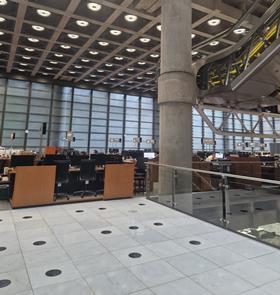To flourish, the Lloyd’s Underwriting Room and market participants need to ‘get that trading mojo back’
Underwriters’ attendance at Lloyd’s of London has recently become a “point of contention” for young brokers and, following a deep dive into the issues at play, Insurance Times found the future of the market “is very much at risk, not least because there are fewer junior staff learning their trade”.

That was according to members of Aston Lark’s senior Lloyd’s broking team, who – following earlier claims made by the London and International Insurance Brokers Association (Liiba) – told Insurance Times that underwriters’ attendance at Lloyd’s had indeed “dropped”.
Liiba’s report – which was published in June 2023 before Lloyd’s closed its underwriting room for refurbishment at the beginning of July until mid-September this year – noted that underwriters had reduced their time at the box to only Tuesdays, Wednesdays and Thursday mornings.
Concerns were also raised that insurers’ attendance rotas, which tend to be circulated to brokers on Sundays, were often left unfulfilled. Some even cited instances when overseas contacts had made remarks about the lack of staff in the market on Fridays.
Liiba’s chief executive Chris Croft explained that “where underwriters are in Tuesday, Wednesday or Thursday, they often don’t reappear after lunch. So contact is harder”.
And Thomas Curtis, chief executive at The Curtis Consultancy – an Asian-based intermediary working with the Lloyd’s market through London brokers – also pointed out that “it is very obvious that the market is working three days a week in the city and available for meetings with brokers”.
The reason why attendance had dropped, Aston Lark’s team believed, was primarily a result of the Covid-19 pandemic, which then forced the market to close and people to work electronically. Staff working from home therefore “got used to emails and placements via PPL”, instead of trading in-person.
Croft additionally noted that “competing agendas seem to be distracting underwriters away from the box – particularly a proliferation of online meetings with overseas offices, hence the afternoon absences”.
As a result of these challenges, as well as a “lack of people prepared to take decisions at the box”, Croft said that “it risks making [face-to-face] negotiation less effective and that could see London struggle to write the sorts of complex risks that other centres can’t”.
“If that happens, our role as the global centre of excellence for specialty insurance will be under threat,” he added.
Considering the current trading environment, Peter Blanc, chief executive at Aston Lark and head of M&A at Howden, said: “Excellent collaborative interaction between experienced underwriters and trusted brokers is a proven way of solving clients risk problems – creating bespoke solutions for as many of life’s challenges as possible is how the insurance profession grew and as a market we lose this interaction at our peril.”
He further noted that “insurance has long faced a crisis of relevance” and if it becomes a market that “shies away from emerging and challenging risks” it “will fast become irrelevant”.
So, with brokers’ concerns in mind, what is the perspective of underwriters operating in Lloyd’s?
Remote working impact
Simon Hearn, interim chief underwriting officer for the UK and Lloyd’s at Axa XL, said that “hybrid-working has had a part to play and underwriters have recognised that for some lines of business it is more efficient to trade remotely”.
Read: Colm Holmes – ‘Strong relationships’ with brokers is ‘a core part of our strategy’
Read: How broker systems and extranets can be improved to enhance eTrading experience
Explore more broker-related content here or discover other news analysis here
However, Hearn highlighted that attendance for Axa XL at Lloyd’s had “progressively increased with a marked improvement in H1 2023 [that was] largely focused around Tuesday, Wednesday and Thursday across the majority of business classes” both pre-refurbishment and post-Covid.
As Lloyd’s renovates, Hearn said that Axa XL had taken up a temporary trading space within gallery three at Lloyd’s for its specialty classes, as well as setting up pop-up boxes within its Gracechurch Street offices for all other classes.
“It is a short-term solution to encourage continued face-to-face trading and we are looking forward to getting back to the room after the summer,” he said.
Axa XL Insurance – part of Axa Group – manages Syndicate 2003 and Syndicate 3002.
A spokesperson for Lloyd’s exclusively told Insurance Times that every managing agent had been offered the opportunity to have space on the ground floor.
“The equitable allocation of space on the ground floor was the primary driver for the refurbishment, as many managing agents wanted to have a position on the ground floor, which they now have,” they added.
“This work sets out solid foundations for us to build on, ensuring the [underwriting] room continues to be the destination for in-person trading and delivering the unanimous ambition that came out of our consultation for its ongoing future success.”
In Insurance Times’ latest 2023 Commercial Lines Five Star Ratings Report, published 8 February 2023, broker respondents reported that accessibility to underwriters at Axa ranged from a rating of excellent for marine lines to poor in motor fleet. Overall underwriting experience for the insurer received a broker rating of two stars – down from three stars in 2021/22.
Potential solutions
To address the current trading challenges, Blanc said that “there’s a willingness from carriers to deploy capital – there is proven need from clients to transfer risk, so between brokers and underwriters we have to figure out how to make this happen effectively, efficiently and quickly”.
“eTrading helps the efficiency part of the equation but face-to-face broking is a vital part of solving the more challenging requirements of our clients,” he added.
Aston Lark’s team said that trading in-person would also make it “hard to ignore the broker standing in the queue”, whereas “emails and PPL requests could easily be ignored”.

Nathan Riddle, founder of Riddle and Riddle Insurance Services, said that “nothing beats meeting with an underwriter, shaking hands on a deal and building on that relationship”.
“I’ve not experienced the trading floor but have had several tours around Lloyd’s and always loved the idea of old school trading. Relationships via email versus relationships face-to-face will never be the same,” he added.
Echoing Riddle’s views, Croft said that “the room should still be at the centre of Lloyd’s of London’s competitive advantage”, but the market needs to “get that trading mojo back” – meaning that “people need to be there and they need to be in a position to take decisions”.
He added that Liiba was “keen to have a chat with Lloyd’s and the LMA” about how it could address the issues raised in its report.
“We accept that much of the issue over decision making is driven by compliance. The need to carry out appropriate modelling and capital management can make it difficult to bind on the spot, but prior submission of risk details might be a way of resolving this,” he said.
“We think that with constructive discussion we can find a way to revitalise the room as a trading floor. The refurb is welcome but, as we said in our report, brokers will sit on an upturned cardboard box if it means they can talk to the underwriter who can provide the product their client needs.”
Hearn, on the other hand, said that improvements to the underwriting room were “an important development for the market and having a greater mix of syndicates on the ground floor is essential for the market dynamic”.
“If face-to-face trading is to continue and act as a breeding ground for the next generation of Lloyd’s underwriters then there needs to be commitment from underwriters and brokers alike to ensure that we don’t have a skills shortage in the future,” he added.
In terms of changes to the underwriting room post-refurbishment, a spokesperson for Lloyd’s revealed that the market can “expect to see changes to the style of underwriting boxes, additional furniture, layout and improved infrastructure”.
“We know the ability to negotiate complex risks face-to-face between Lloyd’s expert underwriters and brokers is, and will continue to be, an important element of our global and growing market,” Lloyd’s said.
“The next chapter of the underwriting room must build on our rich heritage, while creating a unique experience that provides flexibility, supports growth, attracts new talent and enables all market participants to come together to trade and collaborate.”
Hosted by comedian and actor Tom Allen, 34 Gold, 23 Silver and 22 Bronze awards were handed out across an amazing 34 categories recognising brilliance and innovation right across the breadth of UK general insurance.




















































No comments yet